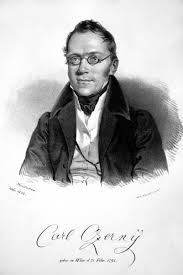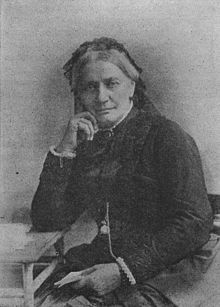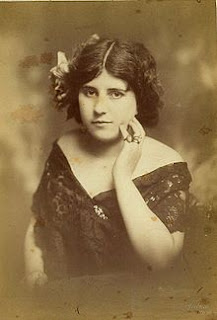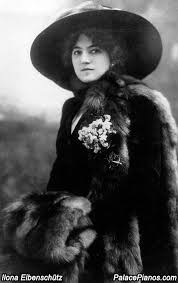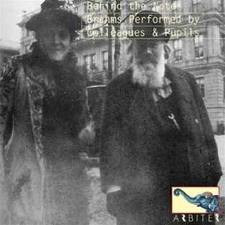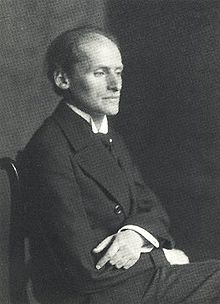Bored with Czerny? Wondering why play exercises at all? Me too.
 Here's an excerpt from the introduction to a series of new publications, yes, by yours truly, for developing technique while learning repertoire. I expect the studies to be available in a complete volume containing vols. 1 and 2. Also available will be vol. 1, Least Complex to More Complex, and vol. 2, Still More Complex, Most Complex and Morsels. There's a nifty index where you can look up almost anything. These volumes should be available soon. Watch this space.
Here's an excerpt from the introduction to a series of new publications, yes, by yours truly, for developing technique while learning repertoire. I expect the studies to be available in a complete volume containing vols. 1 and 2. Also available will be vol. 1, Least Complex to More Complex, and vol. 2, Still More Complex, Most Complex and Morsels. There's a nifty index where you can look up almost anything. These volumes should be available soon. Watch this space.
INTRODUCTION
On Dexterity, Velocity and the Halls of Parnassus
Given all of the negative information we have about smoking cigarettes, it startles me that so many people still smoke them. Likewise, given the wealth of scientific information we have today about the physiology of piano playing, I am regularly amazed at how many pianists choose to ignore it. Is it just human nature to cling to dogmas and old wives’ tales of the past, to what is familiar? Could be. To me it seems unreasonable to choose deliberately unhealthy over healthy, whether we’re talking about smoking cigarettes or playing the piano.
What constitutes healthy piano playing, of course, might be up for debate depending upon to whom you speak. For me it’s a settled issue. I choose to play according to the design of the body. That is, I understand and make use of the physiology of the playing mechanism—a unified finger-hand-forearm collaboration—avoiding gestures that work against it, gestures such as stretching to an extreme or actions mistakenly thought to increase strength. This collection of studies, while not offered primarily for the purpose of teaching specific techniques, provides a way to maximize the efficient learning of repertoire and, concurrently, increase technical awareness regardless of the technical approach.
In the mid-1960s, Rosina Lhevinne was still the reigning empress of piano at the Juilliard School. I never had the pleasure of meeting her, this last vestige of the Russian Romantic tradition, though one frosty morning as I rushed to class, I came close to earning a place in infamy by nearly crushing the fragile octogenarian in a revolving door. A good friend studied with her and often reported to me details of her encounters with Madame. One such report made an impression, though I wouldn’t know to what extent for many years. My friend wanted to play Robert Schumann’s “Carnaval,” and when she broached the topic with Madame Lhevinne, the response was, “bring in Paganini next week, dear, and then we’ll see.” Paganini, of course, is the devilishly difficult leaping movement and would be a stumbling block for any pianist. The wisdom of Madame Lhevinne’s remark reverberates all these years later and is, in a way, an underlying concept of this collection of studies: locate and solve the technical problems first, then proceed. And for our present purposes I’ll add that no one should have to spend time practicing non-music, or something that isn’t particularly useful and that could, if misunderstood, cause harm.
 |
Carl Czerny
"School of Velocity," "Art of Finger Dexterity," et al |
But does the world really need another collection of studies for the piano? The correct answer is yes, if that collection is the antithesis of all those well-meaning, yet misguided exercises we have inherited from the nineteenth century. Why misguided? Carl Czerny, Muzio Clementi and their ilk, exceptional pianists all, played rather different instruments from those we play today. Well, fair enough. Those composers wrote studies for the instruments they knew. More importantly, though, they labored under serious misconceptions about how an efficient technique
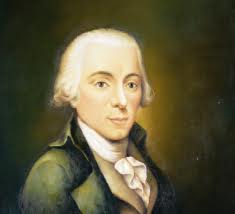 |
Muzio Clementi
"Gradus ad Parnassum" |
works, misconceptions that arose, at least in part, from techniques associated with the piano’s forerunner, the harpsichord.
For Czerny and his colleagues, the technical emphasis was on “finger action,” a “light hand,” or a “quiet hand with fingers active to the utmost.” These suggestions are among the few that Czerny offers in his collection of studies, The Art of Finger Dexterity. In a similar opus, The School of Velocity, the distinguished pedagogue leaves us no instruction at all. Likewise, Clementi abandons us to our own devices in his highly commercial Gradus ad Parnassum (“Steps to Parnassus”), the assumption being, I suppose, that we should provide our own technical knowhow. This begs the question why study them at all? But I’ll get to that in a moment.
In the 1903 preface to Clementi’s opus, C.F. Weitzman states, presumably on the composer’s behalf, that the studies are “calculated to make the fingers independent or to develop the player’s agility, strength and endurance.” They will enable one “to play with ease similar runs and passages in the works of other composers and to acquire the confidence, clearness and routine requisite for the performance of any species of composition.” Did you notice in the preceding quote that Weitzman claims that by practicing X you will be able to play Y? I promise you that even if you learn X by heart and can play it in a sleep-induced trance after a night on the town, you will still have to practice Y. What he is implying, of course, is along the lines of how athletes train, using weight training to strengthen the legs, for example, in order to run a race.
 |
High Fingers
The great harpsichordist Wanda Landowska |
High fingers that are separated from the forearm by means of a non-moving hand, seem to be the implicit premise in all of these collections. In order to achieve dexterity and velocity, it was supposed that strength would be required, strength that would lead to endurance. It follows, then, that in order achieve “strength” a certain amount of training must take place, repetition training of the sort employed by the afore-mentioned athletes. Hence, dating from about the 1830’s we have the appearance on the market extensive volumes of exercises designed to achieve those ends. It is no coincidence that from about this time the piano was fast becoming a ubiquitous household instrument and all the young ladies of the era required finishing in music studies.
 Suppose for a moment that we don’t accept the notion that a good piano technique requires strength training, or that it is even really possible to “strengthen” the fingers to any noticeable degree. Those concepts indeed have long ago been discredited. Suppose, too, we discard the notion that independence of fingers is a physical action and not instead a musical objective. Well, you might ask, for what then do we train? Why any repetition at all? I’m so glad you asked.
Suppose for a moment that we don’t accept the notion that a good piano technique requires strength training, or that it is even really possible to “strengthen” the fingers to any noticeable degree. Those concepts indeed have long ago been discredited. Suppose, too, we discard the notion that independence of fingers is a physical action and not instead a musical objective. Well, you might ask, for what then do we train? Why any repetition at all? I’m so glad you asked.
 |
| Start with an idea. |
In my studio we start with knowledge of how the playing mechanism wants to move, an understanding of the body’s design. Then we begin to train for the development of refined movements for efficient coordination, not in order to build muscle mass. Playing the piano requires very little physical strength—emotional strength, perhaps—nor does it demand a capacity for endurance. A small child can do it. Besides, how can we make music if we have to endure something? Really, why mindlessly repeat an exercise for which we have no other use if we don’t accept its premise? If our understanding of technique gives us the tools to solve technical problems, then why not solve those problems in music we want to play? We can then use repetition training for the purpose of working-in those technical solutions. Let me repeat that. Once we decide on the correct technical solutions, the physical movements required to play a passage fluently with ease, then, and only then, do we repeat those movements. And I would like to add that the brain must be fully engaged at all times.
 |
| Halls of Parnassus? |
I know, I know. My comments border on sacrilege. The inhabitants of Parnassus are doubtlessly reeling. If I seem to be attacking the collective institution of Czerny, et al, well, I suppose I am, though it is not out of malice. My hope is that new generations of pianists will put aside useless dogma and old wives’ tales in favor of reason-based study.
Though many fine pianists have worked their way through Czerny’s “mind-numbing, anti-music catechism,” as one highly-regarded concert artist put it, even at the height of Czerny’s success, not all musicians were on board. Robert Schumann in Die Neue Zeitschrift fur Musik (“New Musical Gazette”) wrote: "It would be difficult to find a failure of imagination greater than that of Czerny." This, I suspect, pertained to a concert piece, but one gets the drift. In Men, Women and Pianos, Arthur Loesser describes Czerny's music as "without depth, intensity, or wit, but always smooth and pretty and rather ear-tickling when played fast—endless variety of patterns and endless monotony of import." I reject Moszkowski’s alleged remark that “Czerny hated little children.”
Czerny died in 1857 having left behind over 1000 works. Only a generation later, though, his reputation had come under attack to the extent that Brahms felt moved to come to his defense. In a letter of 1878 to Clara Schumann he wrote: "I certainly think Czerny´s large pianoforte course Op. 500 is worthy of study, particularly in regard to what he says about Beethoven and the performance of his works, for he was a diligent and attentive pupil. Czerny´s fingering is particularly worthy for attention. In fact I think that people today ought to have more respect for this excellent man"
By most accounts, Czerny by the age of five was considered a prodigy. He studied with Beethoven for a few years and by the age of 15 was a highly regarded teacher. Do you sense an irony here? Yes, Czerny was able to play at the age of five in a way that was favorably compared to adult artists, and yet when he wrote his exercises for "finger dexterity" or to achieve "velocity," he seems to have thought pianists needed physical strength.
If you are one of those countless pianists who grew up studying Czerny, Clementi and the others and feel those studies made you the pianist you are today, or if you like to rattle them off, well, just because, I have no desire to take that away from you. Unlike cigarettes, they probably are not carcinogenic. I do ask you to consider, though, for the sake of music and your sanity, the why of it. I do hope to dissuade you from the conviction that by playing Czerny and Clementi studies you will somehow become “stronger” and therefore a better pianist, that they will enable you, necessarily, to play other music with similar passages or that you will become a better musician. Put your Czerny and Clementi and
 |
| Put them all in here. |
the others in the closet and turn the key. Use the music itself for your studies. To that end, I have compiled and edited for our mutual convenience this collection of studies drawn from music we want to play. Whether you have suffered the mind-numbing dogmas of the past or whether you are as yet untouched by nineteenth century approaches to piano studies, I urge you give this new collection a try. Make it a part of your daily routine, and at the very least you will give your pianistic self a colossal head start on much of the standard repertoire.

















